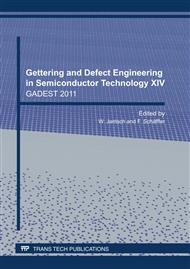p.50
p.56
p.61
p.67
p.72
p.79
p.88
p.94
p.100
C-V - and DLTS-Investigations of Pyramid-Shaped Ge Quantum Dots Embedded in N-Type Silicon
Abstract:
We investigate self-assembled pyramid-shaped Ge Quantum Dots (QDs) with lateral dimensions of 15 nm, and heights of 2.5-3 nm. These Ge QDs were grown by Molecular Beam Epitaxy (MBE) on n-type Si(100) substrates using the Sb-mediated growth mode. The resistivity of the substrates was about 5 Ωcm. The Si buffer layer below the QDs and the Si capping layer above them were doped up to 1018 cm-3 by Sb. Cross-section transmission electron microscopy shows the QDs and the Sb delta-doped layers. Using standard photolithographic techniques, a 0.3 mm2 Au Schottky contact was applied to the epilayer, while an Ohmic contact was formed on the back side of the substrate. Plotting C-2 vs. V plot reveals the nominal doping of 1018 cm-3. DLTS studies revealed two levels with fitted activation energies of 49 meV and 360-390 meV. They are related to the Sb doping and the Pb interface states, respectively. The simulation suggests a deep level with a volumetric concentration of 2.55×1015 cm-3. Multiplying this value by the thickness of the depletion region obtained from the CV measurements, we find that the deep level capture about 5.8×109 electrons per cm2.
Info:
Periodical:
Pages:
72-75
Citation:
Online since:
August 2011
Keywords:
Price:
Сopyright:
© 2011 Trans Tech Publications Ltd. All Rights Reserved
Share:
Citation:


